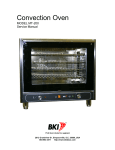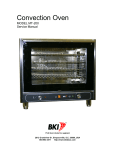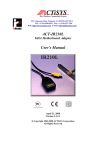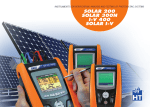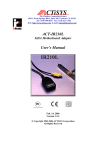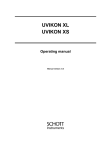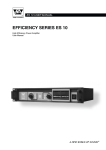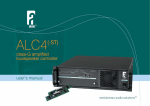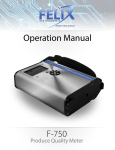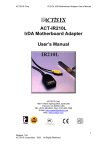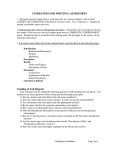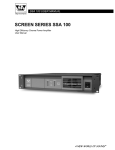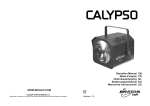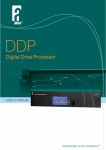Download StaRRcol manual ENG
Transcript
USER MANUAL STARRCOL MANUAL 1.10 Master Registration Number: MRN006 Manufacturer: Mechatronics Manufacturing B.V. Phone: +31 (0)229 - 29 11 29 Fax: +31 (0)229 - 29 11 24 E-Mail: [email protected] Website: http://www.mechatronics.nl Postal address: P.O. Box 225 1620 AE Hoorn The Netherlands Office address: De Corantijn 13 1689 AN Zwaag The Netherlands © Copyright Mechatronics BV All rights reserved. Subject to changes without prior notice. Issued by the After Sales Department of Mechatronics Guarantee Guarantee The manufacturer guarantees to repair any manufacturing faults or defective materials or both in the products supplied. Excluded are materials that become defective due to normal usage, such as needles, syringes, glass-ware, tubing, O-rings, etc. The guarantee period commences on the day of delivery to the customer and shall be effective for a period of twelve (12) months. No claims for guarantee can be made on Mechatronics Instruments BV if fluids and/or spare parts of other manufacturers than those prescribed in the manual are used. The manufacturer, Mechatronics Instruments BV, takes no responsibility for the consequences of errors, which might appear in this manual in spite of every effort made in translations. StaRRcol Manual Version 1.10 Page 3 Contents CONTENTS 1. INTRODUCTION ............................................................................................................ 7 2. DIFFERENT MODELS ................................................................................................... 9 3. SAMPLE MEASURE UNIT .......................................................................................... 11 4. MEASURING METHODS............................................................................................. 13 5. INSTALLATION ........................................................................................................... 15 5.1. StaRRcol Initialising procedure .............................................................................. 17 6. STARRCOL DESIGN ................................................................................................... 19 7. STARRCOL FUNCTIONS............................................................................................ 21 7.1. Routine measurements .......................................................................................... 23 7.1.1. Measurements by using a standard. .............................................................. 23 7.1.2. Measurements with sample or reagents blank. .............................................. 23 7.2. Accuracy and display ............................................................................................. 25 7.2.1. Light source replacement ............................................................................... 26 7.2.2. Checking the light source ............................................................................... 27 8. IFL FILTER CONTROL ................................................................................................ 29 9. SPECIFICATION .......................................................................................................... 31 9.1. RS232 protocol....................................................................................................... 35 9.2. StaRRcol Current Output 4 .. 20 mAmp (Optional). ............................................... 37 9.2.1. Dutch: ............................................................................................................. 37 9.2.2. English:........................................................................................................... 37 10. INDEX........................................................................................................................... 39 StaRRcol Manual Version 1.10 Page 5 Introduction 1. INTRODUCTION The StaRRcol is a micro processor controlled filter photometer. Due to application of modern electronics, micro-processor controlled and high quality Köhler-optics the StaRRcol is very easily to operate and a reliable photo-meter. Low as well as high range absorption can be measured with high accuracy. The user's interface consists of a keyboard a 16 character back-lighted LCD display with large characters and a parallel (IBM compatible) printer port. The reliability is increased by absence of a fan, mechanical chopper, potentiometers etc.. Also the lifetime of the light source is optimised by the micro-computer (controlling the voltage and the current of the light source). Through that the light source lights and heats the sample not more as strictly needed. The Köhler optics sends through the cuvet and the filter an almost parallel homogeneous light beam. In this way the best results can be expected. StaRRcol Manual Version 1.10 Page 7 Different models 2. DIFFERENT MODELS The StaRRcol photometer is available in two models. Please contact your dealer for details. ! Standard including parallel printer port, remote control and analogue output 0..4 V. (0.000 .. 4.000 Ext.) ! As above mentioned, including a RS232 serial port for a bi-directional connection to a host (PC) computer system. StaRRcol Manual Version 1.10 Page 9 Sample measure unit 3. SAMPLE MEASURE UNIT The standard measuring unit is a cuvet holder that contains a continuous chamber diameter 30 mm. In this chamber different sizes and types of measuring cuvettes with a length up to 25 mm. can be placed. The continuous (open) chamber prevents liquid flowing into the instrument. The advantage of such a construction is that a continuous flow system can be implemented easily. Special replacements are available for cuvettes (light path length) up to 60 mm. The standard light source and optics give a homogeneous lighted rectangular surface of 3 x 9 mm. (other surfaces possible at request). StaRRcol Manual Version 1.10 Page 11 Measuring methods 4. MEASURING METHODS The StaRRcol has been developed to measure sample concentrations in a homogeneous solution. The intensity of the remaining light is detected, after it passed through the sample. The wavelength of the light source is set by interference filters. These filters can be combined, if needed, by so called cut-off filters. The standard filters have a bandwidth of 8 to 12 nm. The reading can be in Transmission, Extinction, or directly in Concentration values. Gauging in units of concentration can be done by setting the factor or by use of standard gauge solutions by setting the concentration. The number of decimals of the reading can be set separately. The relation between the concentration and the light absorbency of the solution is described by Lambert-Behr. This laws only apply by use of monochromatic, homogeneous light on one hand and on the other hand homogeneous liquid solutions without any effects such as: refraction, blocking, reflection, fluoridation etc. Io = Light intensity before the sample. It = Light intensity after the sample. Extinction = E x C x L from which : E =Absorbency of a standard sample with a standard cuvet length, by light of the concerning wavelength (for example: 450 nm, E=330 mE, 1 mmol sample, 1 cm cuvette length). C = Sample concentration. L = Length of the light path through the cuvette. From with follows: C = factor * E (E and L are constants) StaRRcol Manual Version 1.10 Page 13 Measuring methods Out the above follows that the extinction is independent of the intensity of the light source. The stability of the light source however is important for the calibration of the instrument with a sample standard. With the sample blank there is no light absorbency assumed, so: It = Io : Concentration = factor * 0 = 0 The photometer measures the light intensity 'It'. To prevent the necessity to repeat the blanking calibration, a stable light source and signal processing are of great importance. The StaRRcol photometer is able to measure very accurate up to over 3.0 extinction. The accuracy is up to 1.5 extinction better than ! 1 % relative and up to 3.5 extinction ! 2% relative. Page 14 StaRRcol Manual Version 1.10 Installation 5. INSTALLATION Place the StaRRcol photometer on a flat, stable table. Shield the instrument from direct sunlight. Check if the correct voltage has been selected and plug the cord in the instrument. Connect if needed the printer/computer cables. Place the desired IFL filter in the filter unit at the front side of the instrument, and place the desired cuvette adapter. The adjust pin of the cuvette holder should fit into the groove of the measure chamber. Fix the adapter with the locking screw on front of the instrument. The StaRRcol can now be switched on. StaRRcol Manual Version 1.10 Page 15 Installation 5.1. StaRRcol Initialising procedure After switching on the display reads "StaRRcol vrs xx" After a few seconds the display reads "REAL BLANKING" . During this time (approx. 15 sec.) the light source will be adjusted to the most optimum dynamic range. The light source will be adjusted in such a way an optimum is achieved in dynamic range and lifetime of the source. After the "REAL BLANKING" procedure a stabilisation test is performed and the display reads "STABILIZING (br)". Every 20 seconds during this procedure will be checked if a minimum stability is achieved. Only at a stability level better than 1 m Abs. the stabilising procedure breaks automatically and starts absorbency readings. The stability procedure can be interrupted by pressing the 'BREAK' key. The stabilisation time depends on the IFL-filter and the condition of the light source. The StaRRcol is ready for use now, after it actually performed a blanking. If time is important you can put your 'blank' sample into the cuvette before switching on the instrument. In this way the instrument is stable and blanked in the most economically way (of spending time). The StaRRcol starts the working condition from its operation mode of latest use, switching over to another measure method can simply be done by pressing the key 'FUNCTION' and the key reading the desired method: (key 7 = transmission, 8 = extinction, 9 = concentration). StaRRcol Manual Version 1.10 Page 17 StaRRcol design 6. STARRCOL DESIGN On the top side (Figure 1) of the instrument are a keyboard, a 16 character backlighted LCD display and the measure unit located. The keyboard has 16 keys, the figures 0 .. 9, and a few special keys and a shift key to activate special functions. The top side of the instrument is made of a foil, it covers the whole top side, including the keyboard and the display. Constructed this way the instrument is protected against liquids which might be spoiled over the instrument. and it is also very easy to be cleaned. The LCD (Liquid Crystal Display) has 16 characters, sized 14.5 by 7.2 mm. The measure unit is made of a plastic based rectangular block with a hole of 30mm. diameter. In this hole fits a holder which can hold several different shaped types of cuvettes Available are extractor cuvettes, flow through cuvettes, standard square cuvettes, circular cuvettes. For huge cuvettes (light path up to 60 mm.) special adapters are available. On the front left hand side, the light source is located behind a cover. With an Allen-key driver the light source can be adjusted to the most optimum performance (highest output). Behind the measure unit, on the right hand side, the filter unit is located. The interference filter has a bandwidth of 8 and 12 nm. The IFL-filter is been placed behind the cuvet to minimise the effect of 'ghost light', which shines from above into the measuring unit. On the most right side of the instrument the spare filter rack is located. The mains switch is located on the back side of the instrument just above mains cord Euro connector. The parallel Centronics printer connector (IBM compatible), the remote control connector and the RS232 connector (optional) are located more or less in the middle of the rear panel. We recommend that the connectors should be pushed/pulled into the instrument only when the instrument is switched off. StaRRcol Manual Version 1.10 Page 19 StaRRcol functions 7. STARRCOL FUNCTIONS Transmission: Use the function key in combination with key number 7 to activate the transmission mode. The light which remains after it passed the sample is the transmission. The transmission through the blank sample is by definition 100%. Absorption: Use the function key in combination with the number 8 key to activate the absorbency mode. The display reads the Absorbency "extinction" (=light absorbed by the sample). Concentration: Use the function key in combination with the number 9 key to activate the concentration mode. The display reads the concentration. This mode shows the concentration calculated out the absorbency multiplied by the factor. The factor can be set by hand, using the FUNCTION key combined with the number 6 (SET FACT) key. Simply key in the factor including the desired decimals. It is also possible to have the factor calculated: put the standard solution with known concentration into the measuring unit, press the 'SET CONC' key and give in the concentration. If done press the ENTER key, the factor will now be calculated and saved. Full Scale: By means of the FUNCTION key and the FULL SCALE key the decimals can be set or altered. After the function is activated just type the desired decimals (maximum 3). Mind that the accuracy of the StaRRcol always has to be taken into account. Increasing the decimals will not increase the accuracy of the instrument. Mode: By means of the FUNCTION key and the MODE key the user can give in the patient Id. number. This number together with the result will be printed after the print command Blank: This function activates the blanking procedure. If after this command has activated the reading is between + 50 and - 300 mAbs., a quick blank will be performed (also called "software blank"). If the reading exceeds the above mentioned values the instruments starts a full blanking procedure. The light source is adjusted as described above. The display reads "REAL BLANKING". The full blanking procedure takes more time than the quick blank. In practice the full blank will only be necessary by (re)placing another IFl-filter. Print: The print key activates the print-routine. As well the value on the display is printed as the patient Id. number. It is also possible to activate the print command by an external signal (remote connector). Enter: Confirm key to (enter) accept values etc Break: Escape key to break functions or key hits (without changing former settings) StaRRcol Manual Version 1.10 Page 21 StaRRcol functions Page 22 StaRRcol Manual Version 1.10 StaRRcol functions 7.1. Routine measurements Place the desired IFL filter in the filter rack. Place the desired cuvet holder and put in the blank sample. Switch on the StaRRcol or press the "BLANK" key. Set the desired mode after the blanking procedure. When the transmission or absorption mode has been selected the StaRRcol is ready for use. Replace the blank with the samples and read the display and/or press the print key. When the concentration mode is selected first the desired factor should be given in. 7.1.1. Measurements by using a standard. Place the blank sample and press the BLANK key. Place next the standard (gauge) solution and press the FUNCTION key and the SET CONC key, give in the concentration of the gauge solution and press ENTER. The factor will be calculated and the display reads the keyed in concentration. The calculated factor can be displayed by pressing the FUNCTION and the SET FACT. Key ENTER or BREAK to start concentration measurements. 7.1.2. Measurements with sample or reagents blank. When a reagents blank is needed, place the reagents blank into the measure unit and press blank. During all the next sample measurements the reagents blank will be taken into account. By measurements using a 'sample blank' the above described instruction should be also carried out, but instead the reagents blank a 'sample blank' should be performed. Performing of the samples place them in a sequence into the StaRRcol and wait 2 seconds and read the display or press PRINT. StaRRcol Manual Version 1.10 Page 23 StaRRcol functions 7.2. Accuracy and display The StaRRcol has a maximum accuracy of 12 bit and a maximum of 5 digits can be displayed (including the decimals). The displayed range is in between: -1000 tot 32768. Automatic scaling is performed. Possible scaling -1.000 .. 32.768 -10.00 .. 327.68 -100.0 .. 3276.8 -1000. .. 32768. Whenever a reading is out of range, the message 'overflow' will be displayed. The modes absorbency, transmission and concentration will adjust the decimals automatically. Transmission 0.00 .. 9.99 10.0 .. 99.9 (en 100.) Absorption 0.000 .. 4.096 -.300 .. 3.796 Note:For concentration calculations a factor of maximum 4 digits can be entered. Concentration 0.001 .. 9.999 00.01 .. 99.99 000.1 .. 999.9 0001. .. 9999. (Manual altering the displayed decimals will not alter the accuracy of the instrument.) StaRRcol Manual Version 1.10 Page 25 StaRRcol functions 7.2.1. Light source replacement On the left hand side (front side) a protecting shield is situated. Unscrew the locking screw and remove the protecting shield. The light source is locked with two allen-keys, turn the allen-keys a few turns counter clock wise and remove the light source (See also figure 3). Replace the light source with a new one and mount it again. Do not touch the light source with your fingers or hand, it will certainly shorten the lifetime of the light source. Be sure the allen-keys are firmed correctly and replace the protecting shield. Adjust the light source (put the allen-screw driver thus far into the two holes on the front of the instrument) to minimum absorbency or maximum transmission. If both screws are tightened or loosened equally the light source will move forwards or backwards. If only one screw is tightened or loosened the light source will overturn a bit. Page 26 StaRRcol Manual Version 1.10 StaRRcol functions 7.2.2. Checking the light source Stability: The stability of the light source is checked during the stabilising procedure during start up. If this procedure takes longer than usual ( < 120 sec.) check the light source adjustment or replace the source. Light intensity: The maximum light intensity is degreasing during its lifetime. If during blanking the 'BLANK ERROR' appears on the display, check the light source adjustment or replace it. StaRRcol Manual Version 1.10 Page 27 IFL filter control 8. IFL FILTER CONTROL It is recommended to check the IFL filter at least once a year. It is very common to use a scanning spectre-photometer in co-operation with a chart recorder. It is very important to check not only the wave length but also the bandwidth and also to examine the double wave length. StaRRcol Manual Version 1.10 Page 29 Specification 9. SPECIFICATION Specification: Weight Dimension (LxHxW) StaRRcol Manual Version 1.10 5 Kg 380 x 270 x 120 mm Page 31 Specification Mains Switch over to: Fuses (Slow blow) 220-240V, 50-60Hz 105-120V, 50-60Hz 220V, 0.5A 110V, 1.0A Slow Blow Dissipation Light source Photocell IFL filters Wave length range Dynamic range Accuracy light path Beam surface Cuvette holder Not standard holders Display Keyboard RS232 connection Printer connection Remote control Page 32 < 35 W Wolfram, 12V/15W Semiconductor, Silicium 310 - 1050nm. Several different wave length with a bandwidth of 8-12nm. Wolfram 340 - 1000nm 0 .. 4096 mAbs. (-300 .. 3796) 1mAbs Standard 10mm, other light path on request. (max. 50 mm). 3x9 mm. Circular, 30 mm Several shapes are available, as well as circular, square sized, drain cuvette, flow cuvettes. Cuvette holders for light path longer than 10 mm possible on request. 16 Character, 14.5 mm high, 7.2 mm width 16 positions, tinfoil with click. IBM compatible, 9 pins Sub D male connector Pin 1,6,4 shortened. Pin 2 - RD Pin 3 - TD Pin 5 - Gnd Pin 7 - RTS Pin 8 - CTS Pin 9 - N.C. Centronics, IBM compatible, 25 pins Sub D female connector. 9 pins Sub D female connector StaRRcol Manual Version 1.10 Specification Remote print: Analogue output: Optional: StaRRcol Manual Version 1.10 Pin 1 10..100 msec. pulse, TTL compatible high active. Pin 6,7,8 and 9 - Gnd Pin 2,3 and 4 - N.C. Pin 5 0 .. 4 Volt, Current output 4 .. 20 mAmp Page 33 Specification 9.1. RS232 protocol Connected via the serial port of a PC the StaRRcol can send data to a PC, or when the connection is bi-directional, the StaRRcol can be controlled by a PC. Three commands are available to set the StaRRcol in a particular mode. Commando 11 12 12 Mode ($0B) transmission mode ($0C) concentration mode. ($0D) extinction mode. The below standing command is having the StaRRcol transmitting a measurement result to the PC. 01 ($01) transmitting a measurement. StaRRcol sends totally sixteen (ascii) characters to the PC. In fact the display reading is copied to the serial port. The baud rate is (intern) adjustable to 1200, 2400 (default), 4800 en 9600 baud. The jumper to select the baud rate is situated opposite to the RS232 connector on the printed circuit board. The jumper setting nearest to the connector has the highest baud rate (9600). The StaRRcol is provided with a battery RAM to save variables also when the instrument has been switched off. StaRRcol Manual Version 1.10 Page 35 Specification 9.2. StaRRcol Current Output 4 .. 20 mAmp (Optional). 9.2.1. Dutch: De StaRRcol kan als optie uitgerust worden met een stroomuitgang (4 .. 20 mAmp). Deze stroom uitgang loopt synchroon met de Extinctie waarde 0 .. 4096 mExt. en levert daarbij een stroom van 4 .. 20 mAmp over een belastingsweerstand van maximaal 100 Ohm (de belastingsweerstand mag liggen in de range van 0 .. 100 Ohm). Als voorbeeld: Bij een Extinctie van 947 mExt. levert de stroom uitgang een stroom van 4+((947/4096)*16) = 7.70 mAmp. Bij een Ext. Van 0 mExt. levert de stroom uitgang een stroom van 4 mAmp De stroomuitgang is verbonden met pin 5 (stroomuitgang), de retouraansluiting is pin 6,7,8,9 (ground) van de 9 polige subD connector. De stroomuitgang stelt zich automatisch in bij een ‘blanking’ en levert dan per definitie 4 mAmp. De lineairiteit is beter dan 1% relatief, de offset is na temperatuur stabilisatie beter dan 4% relatief. Belangrijk is dat het instrument eerst 20 minuten moet opwarmen voor de meest stabiele instelling. 9.2.2. English: This StaRRcol is equipped with a current output (4 .. 20 mAmp). The current output is synchronised with the Extinction output. The StaRRcol generates an output of 4..20 mAmp over the (theoretically) full range of 0 .. 4096 mExt. The maximum load resistant is 100 Ohm (in other words should be equal or less than 100 Ohm). Example: An Extinction of 947 mExt. generates a current output of 4 + ( ( 947 / 4096 ) * 16 ) = 7.70 mAmp An Extinction of 0 mExt. gives a current output of 4 mAmp. The output current flows from pin 5 and the returns at pin 6,7,8,9 (ground) of the 9 pin subD connector. The current automatically zeroes (4 mAmp) at ‘blanking’. The current output linearity is better then 1% relative, the offset is (after temperature stabilisation) better than 5% relative. The instrument should warm up for at least 20 minutes to achieve the above mentioned figures. StaRRcol Manual Version 1.10 Page 37 Index 10. INDEX A Accuracy and display 25 C Checking the light source 27 D DIFFERENT MODELS Dutch: 9 37 E English: 37 G Guarantee 3 I IFL FILTER CONTROL INSTALLATION INTRODUCTION 29 15 7 L Light source replacement 26 M Measurements by using a standard. 23 Measurements with sample or reagents blank. 23 MEASURING METHODS 13 R Routine measurements RS232 protocol 23 35 S SAMPLE MEASURE UNIT SPECIFICATION StaRRcol Current Output 4 .. 20 mAmp (Optional). STARRCOL DESIGN STARRCOL FUNCTIONS StaRRcol Initialising procedure StaRRcol Manual Version 1.10 11 31 37 19 21 17 Page 39









































